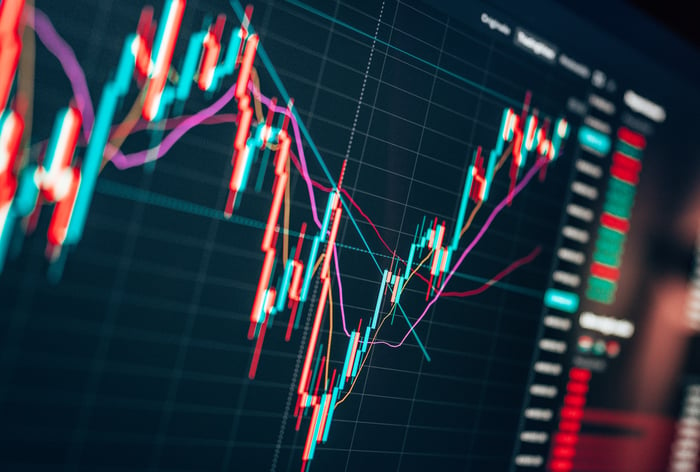It's been a trying year for the investing community. Since hitting all-time highs during the first week of January, the widely followed Dow Jones Industrial Average and benchmark S&P 500 have dipped by as much as 15% and 20%, respectively.
Meanwhile, it's been an even tougher slog for the tech-driven Nasdaq Composite and the Nasdaq 100, the latter comprising 100 of the largest nonfinancial companies listed on the Nasdaq exchange. Both the Nasdaq Composite and Nasdaq 100 have fallen close to 30% from their record-closing highs, placing both indexes firmly in a bear market.

Image source: Getty Images.
Although bear market declines are characterized by heightened volatility and poor investor sentiment, history has repeatedly shown that they're the ideal time to put your money to work. Over time, every notable drop in the major indexes, including the Nasdaq 100, has been completely wiped away by a bull market rally.
What follows are three Nasdaq 100 stocks that can confidently be bought hand over fist in June by long-term investors.
Intuitive Surgical
The first Nasdaq 100 stock that's ripe for the picking by opportunistic investors is robotic-assisted surgical systems developer Intuitive Surgical (ISRG 0.59%).
Whereas most healthcare stocks are (pardon the pun) immune from economic downturns, the pandemic proved to be a headwind that Intuitive Surgical struggled to overcome, at least temporarily. Elective procedures were pushed weeks or months down the line, which hurt some of the company's key revenue channels.
However, it's important to recognize that this isn't a demand issue. Rather, it's a once-in-a-generation economic shock that won't have any lasting impact on Intuitive Surgical's competitive edge or its sustainable double-digit growth potential.
When March came to a close, Intuitive Surgical had an installed base of 6,920 of its da Vinci systems in hospitals and surgical centers. While that might not sound like a lot, it's far more than any of its competitors combined. Because these systems are pricey ($500,000 to $2.5 million), and there's significant training required for surgeons to use them, buyers tend to remain customers for a very long time.
As an Intuitive Surgical shareholder, what excites me most about the company is the expectation that operating-margin growth will handily outpace sales growth for many years to come. During the 2000s, the company brought in most of its revenue by selling its pricey systems. Unfortunately, the margins associated with the da Vinci are mediocre at best, due to the complexity of these systems.
Over time, selling instruments for each new procedure and servicing these systems have grown to make up the bulk of annual sales. Instruments and services generate considerably higher operating margins than da Vinci system sales.
In other words, Intuitive Surgical is running the ultimate razor-and-blades operating model. It sells the low-margin razor (the da Vinci surgical system) and keeps the customer hooked with high-margin blades (instruments, other accessories, and servicing).

Image source: Starbucks.
Starbucks
A second Nasdaq 100 stock that's begging to be bought hand over fist by investors in June is coffee chain Starbucks (SBUX 0.47%).
Shares of Starbucks have lost close to 40% of their value in less than a year due to a confluence of factors. Wall Street appears to be concerned with unionization efforts in select Starbucks stores, rapidly rising coffee prices, and COVID-19 lockdowns in certain Chinese provinces that have resulted in the closure of some Starbucks locations. While these headwinds are liable to persist throughout 2022, none of them should be expected to derail the chain's growth strategy.
One of the best aspects of Starbucks is the company's exceptionally loyal customer base. At the end of the fiscal second quarter (April 3), the company had 26.7 million active Rewards program members. These Rewards members are more likely than nonmembers to have larger tickets, take advantage of mobile ordering, and store their payment information on their smartphones for easy access. In short, they're helping Starbucks' stores and drive-thru lines become more efficient -- and all it's costing Starbucks is a free drink or food item every now and then.
To build on this point, Starbucks' products have proved to be relatively price inelastic over the long run. What I mean by this is that the company has had no issue passing along price hikes that stay well ahead of the inflationary curve. Loyal customers are willingly paying higher prices because they love the product and the brand.
Starbucks also deserves plenty of Brownie points from the investment community for its innovation. The company recently redesigned its drive-thru ordering boards to promote higher-margin drink-and-food pairings, as well as allow its baristas to video-chat with drivers, thereby preserving the in-store engagement that keeps consumers coming back on a regular basis.
Even with a multitude of near-term headwinds, there's a "latte" to like about Starbucks for patient investors.

Image source: Getty Images.
Broadcom
The third Nasdaq 100 stock worth buying hand over fist in June is semiconductor solutions company Broadcom (AVGO 3.84%).
If there's a knock against Broadcom, it's that semiconductor stocks are highly cyclical. With inflation soaring to four-decade highs and the Federal Reserve aggressively raising interest rates, there's a growing expectation on Wall Street that the U.S. could enter a recession. Keep in mind that first-quarter gross domestic product surprisingly retraced by 1.4%. When recessions strike, it's not uncommon for semiconductor stocks to feel the pinch.
But this is a two-sided coin. Even though recessions are inevitable, periods of economic expansion last disproportionately longer than recessions. Buying and holding cyclical stocks like Broadcom allows long-term investors to benefit from the natural expansion of the U.S. and global economies.
Aside from long-term macro factors working in its favor, Broadcom's bottom line should benefit immensely from the 5G revolution. It's been about a decade since telecom companies upgraded wireless download speeds. Updating their infrastructure to accommodate 5G speeds is expected to lead to a multiyear device-replacement cycle. Broadcom generates most of its revenue from selling wireless chips and accessories found in next-generation smartphones.
What's more, the company's infrastructure-solutions segments might grow even faster. Broadcom supplies connectivity and access chips used in data centers, as well as solutions for next-gen automobiles. The former could prove particularly lucrative, with businesses shifting their data online and into the cloud at an accelerated pace in the wake of the pandemic.
If you need one more solid reason to add Broadcom to your portfolio, consider this: Its quarterly dividend has grown by more than 5,700% since 2010.
With transparent operating cash flow and a record backlog to end 2021, Broadcom is perfectly positioned to reward patient shareholders.





